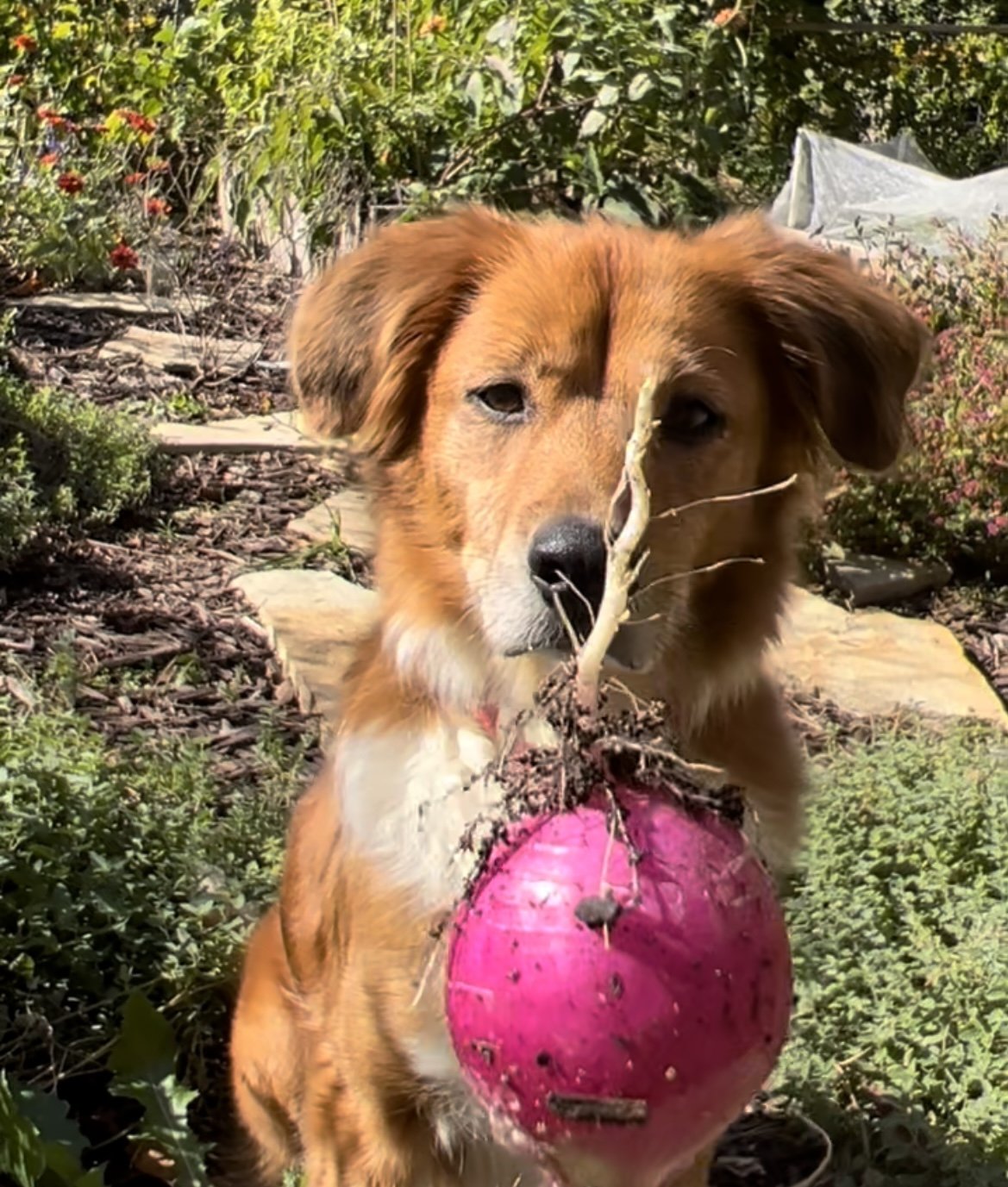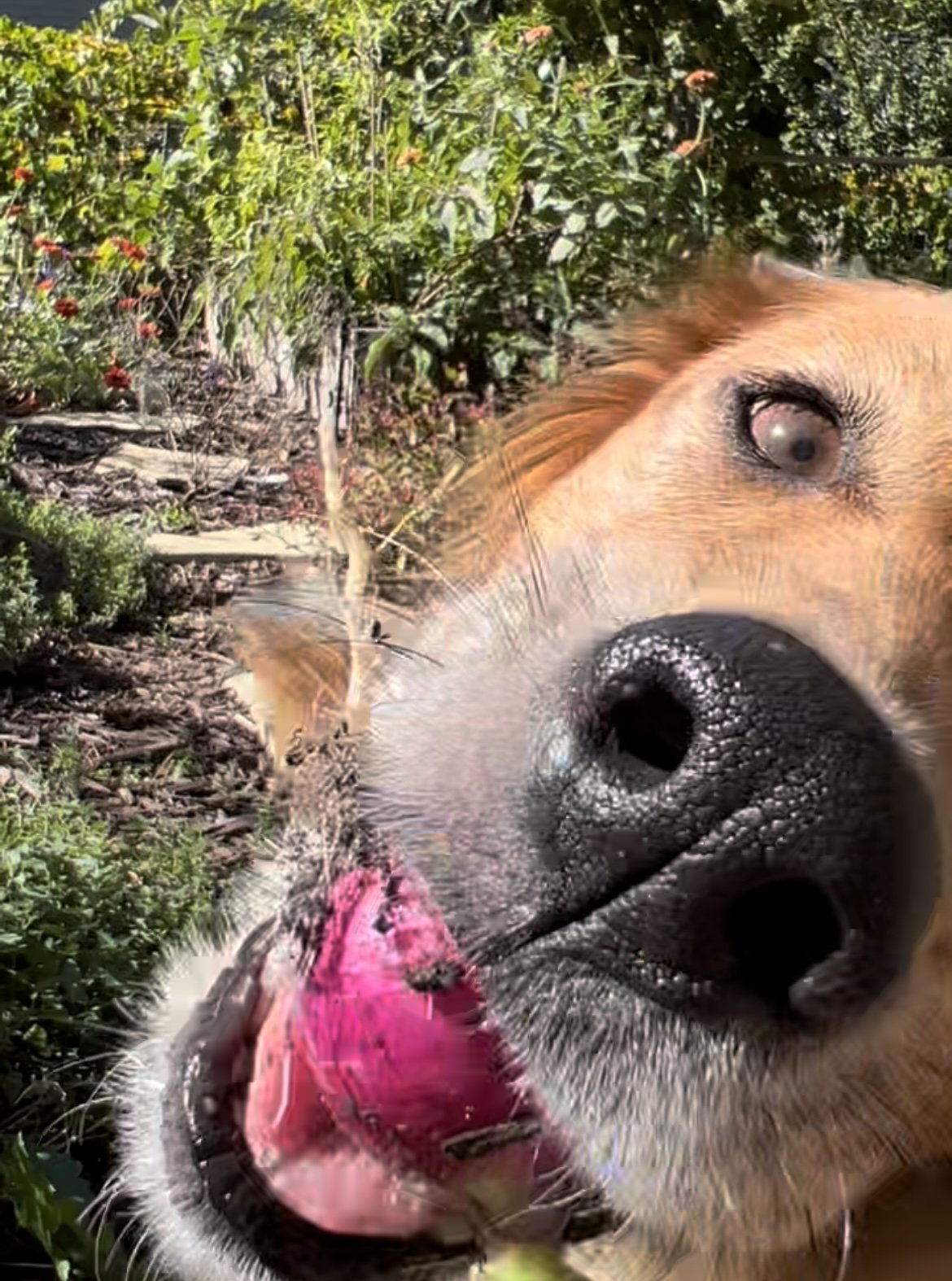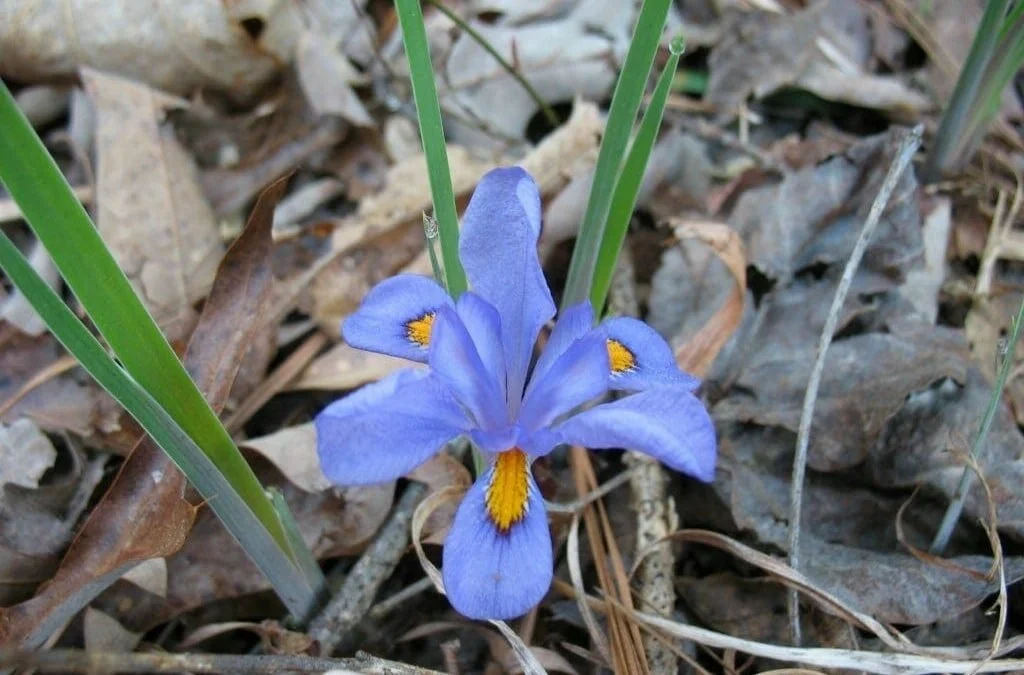October Garden Tips & Tricks for Atlanta and Georgia
October is a busy time in the garden. It sort of feels like the month of last chances - the last chance to harvest summer bounties, the last chance to plant Fall crops, the last chance to wear short sleeves in the garden, the last chance to see butterflies, the last chance to get mosquito kisses, the last chance to sweat profusely in the garden… Didn’t say all the last chances were good!
Lucy Pup, our garden dog, is a big fan of fall veggies. Top on that list: Radishes!
Here’s a look at what we’re doing in our gardens this October:
Harvest - Time to get those last summer crops out! If you haven’t already, harvest your sweet potatoes! Before doing so, be sure to try to cook up some of the edible leaves too! Harvest sweet potatoes is a fun, albeit messy garden task. It’s helpful to pull the vines back so you can see exactly where the original vine was planted. Dig 6-12inches away from that original planting spot to gently turn over your soil to reveal the hidden treasure tubers. If your tubers were grown in-ground, you may want to use a potato fork to turn over the soil. In a raised bed, this task might be easier to do by hard or with a trowel. The tubers will be mostly all be in a bundled group together at that original planting location. However, you will want to root around (pun intended) for any potatoes that grew off the beaten path too. Leave no corner left unturned. If you happen to pierce a potato with your digging tool, do not despair, it is still edible - you will just want to eat it sooner rather than later. Do not wash your sweet potatoes right away. Instead, you will want to cure them. Curing is the process that makes sweet potatoes so sweet, helping their starches convert into sugars. Curing also helps heal any of the little nicks or bruises the potato has so that they can be stored for longer. To cure your harvest, you will want to store your potatoes in a warm (80-85degrees) humid environment for 4-14 days, but not in a direct sunny location.
Late fall harvest of ginger and hibiscus!
Turmeric and Ginger Harvest - If you planted turmeric and ginger in the garden, October or November is the time to pull it out. The leaves should be beginning to yellow a bit, but if you aren’t sure if they are ready, just harvest one plant and see! If you have the space, you can also continue growing them indoors in a container. To harvest these knobby roots, use a shovel and dig 6-10inches away from the base of the plant to loosen the soil and pry up the plant. Very gently brush the soil away from the roots. Turmeric is especially fragile, so move softly. You can choose to let your harvest dry to develop a thicker skin for longer storage times, or use right away. Besides using in cooking, turmeric and ginger are great in teas too. And if you really want to up your health-game, try making some Fire Cider! Fire Cider is an herbal concoction used for keeping cold symptoms at bay, acting as a great decongestnat with anti-bacterial and anti-viral support. There are several variations of Fire Cider, but the general recipe is a base of apple cider vinegar, with chili pepper, ginger, turmeric, and garlic mixed in. You can add other medicinal herbs and ingredients to the mix and let it brew for one month before straining out all the solids. One teaspoon is all you need to heat up your insides and make your eyes open a bit clearer on those icky Winter days.
Remove summer plants - Unless your tomatoes, peppers, eggplants are still reliably producing, it is now the time to say goodbye. Parting is such sweet sorrow, but alas, it is part of life. Move on. If your plant experiences any fungal or high pest issues, we recommend NOT adding the plant debris to your compost and instead tossing it into a faraway area or bagging up for removal. This way, you are not harboring diseases and pests to return next year.
Keep Planting - You can still plant in October! Direct sow radishes, turnips, arugula, smaller asian greens like mizuna, bok choy and tatsoi. Transplant kales, collards, cabbage and broccolis. Especially if you plan to install frost protection, just keep on planting! Even if you have already planted these items, you can establish a succession harvest for plants that are more single-harvest (roots, bokchoy, lettuce heads). Succession Planting is the practice of planting a crop multiple times throughout the season so that you can harvest it at different times. This way, there’s not just one week where you are flush with radishes, but many! Unless you have a pup that loves radishes as much as ours does, then it is best to spread it out!
Garlic - October is the month to plant garlic. I also like to specifically plant it around Halloween as a little way to keep any vampires out of the garden ;) Garlic is a very easy crop to grow, requiring very little maintenance besides keeping it weed-free. It is also a wonderful companion plant in the organic garden! Companion plants are pairs or groupings of plants grown near each other that will help each other’s growth, whether through nutrient provision, structural support, weed suppression or pest protection. Because garlic is so pungent, it makes for an excellent pest repellent, especially for aphids, which plague many Fall-Spring gardens. Plant garlic near your brassica family plants like collards, cabbage, kale, and broccoli. Garlic planted in October will be ready to harvest in May. Which, six months to wait to harvest something does seem like a very long time! But think about just how flavorful and strong garlic is - it needs all that time in the soil to soak up its delicious and nutritious goodness! Planting garlic is very simple and fun! Purchase organic garlic from any store. Break it up into its individual cloves. Dig holes or a trench 2-3inches deep. Pop in the cloves with the flat side down, pointy side up to the sky, placing cloves 4-8inches a part. Cover with soil and mulch. In a couple of weeks, you’ll soon see thin light green grass-like stalks poking through the mulch. There are two different categories of garlic - hardneck and softneck. Hardneck varieties typically have larger, fewer cloves, are more cold hardy, and produce a flowering edible scape in the early Spring. Softneck varieties have more but smaller cloves, are less cold hardy and do not produce scapes. If you have a preference in type, you will have to seek out your garlic source from a nursery or seed retailer. However, you can attempt to make an educated guess on which type they’d be from a grocery store by seeing where the garlic is grown (colder climates typically hardneck) and what the clove composition looks like (many small cloves typically softneck)
Bulbs - Like garlic, October is also the time to plant bulbs in the garden. Daffodils, tulips, hyacinth, Dutch iris, alliums and anemones all do fairly well in our climate. While usually not edible, bulb flowers provide an early source of nectar and pollen for insects, and for humans they are an exciting harbinger for Springtime, bringing pops of color in the quiet Winter grays. Many bulb flowers can also do well in shady spots, letting you take advantage of some underused corners of your garden.
Cover Crop - If you have a lot of garden beds that you won’t have enough plants to fill or are just totally over gardening right now, consider planting a cover crop. A cover crop is an organic agriculture practice where an area is broadly planted with one or a mix of plants that blankets your space in a living mulch. This helps prevent erosion, suppress weeds and typically provides other benefits, whether it’s adding nutrition to the soil, building soil structure, or natural pest protection. These are some of our favorite cover crops:
Daikon Radishes: This is an edible cover crop, where you can harvest the roots or just leaves. The thick leaves provide a great mulch cover, and the deep thick taproot helps aerate the soil. This is a great choice for soils that are clay-heavy and need to be broken up a bit. It is likely that hard, sustained frosts will damage the crop, so if you want to harvest any, do so prior to hard frost.
Field Peas: This is an edible cover crop, where you can harvest the leaves and tendrils, to use in salads or stirfrys. Field peas stay fairly low to the ground and are a nitrogen-fixing legume. This is a good choice for spaces that need to be replenished after an intensive summer planting of a heavy feeder like corn or tomatoes.
Crimson Red Clover: Another nitrogen-fixing legume, crimson red clover is a beautiful cover crop choice that will bloom in early Spring. The flowers can be used in tea as well!
Mustard: This is an edible cover crop, where you can harvest the leaves. Mustard is especially delicious when you mix it with other greens like kale and collards. Mustards are an extremely hardy plant and provide a wonderful dense planting. When they flower in the Spring, it is gorgeous shock of yellow. If you cut them down while they are flowering and till into the soil, it can help with pest protection into the Spring and Summer.
Mulch! - Start mulching around your vegetable garden. Mulch will help protect your plant by keeping the soil warm, suppressing weeds, and pest habitat. Hay straw is great material use - especially with all the Fall themed haybales laying around. However, it is likely that there are hay seeds in the bales commericailly available, so you may experience some grasses popping up from that material. Pine straw is another option readily available. Pine is great and typically less expensive than hay, or you might have it laying around in your backyard already!. The downsides to using pine is that it can be a little uncomfortable to work around, with its sharp ends poking around. They will soften up over time, but if you or your garden users are particularly sensitive to touches like that, consider another option. Woodchips are a wonderful mulch material that can be easily purchased at hardware stores, dropped off by an arborist, or picked up a community sites. Woodchips are probably the most aesthetically-pleasing material to use, so if aesthetics are crucial for your garden, choose this type of mulch. We strongly recommend using woodchips that are NOT FRESHLY CUT. Meaning, the chips have aged for at least a couple of months. When mulching your garden with fresh woodchips, especially when there is a lot of green leaf material mixed in, there is potential for the chemical reactions of decomposition to pull the carbon from your soil to help the mulch break down. This depletes the carbon available in the soil for your plants. Use older mulch or bagged mulch to avoid this issue.
Plants all tucked in to our row covers!
Frost Protection - In Atlanta, the first frost is typically during the first two weeks of November. However, with climate patterns becoming more and more unpredictable, it could always come earlier or not until much later. The point is to be prepared. Many Fall vegetables can tolerate a light frost of 30-32degrees for a few hours. However, once temperatures start dropping below that and/or hold for longer periods of the day, the water-filled cells in the plants will begin to freeze and the cell wall structures get damaged. Providing layers of protection can keep your plants flourishing throughout the Fall and into the Winter. Mulch helps keep the roots of plants warm, but does little for leaf protection. In order to protect your leaves, you will want to create a cover. There are a few methods to do this. The simplest, is to just put a sheet over your plants. This method is only good for a few hours because if you leave it on for too long, the plants will get smooshed and damaged. We find it easiest to make a small investment in low tunnels. Using thick galvanized steel wire or PVC piping you can create low arches over your plants. Then you can drape frost cover like Agribond or a transparent cloth over the arches, securing them down with pins, rocks, or clips. Lettuces, flowering plants like broccoli and cauliflower, spinach and chard are more sensitive to frosts than their hardier Fall friends of collards, kale, arugula and cabbages. So if you are limited in your supplies, prioritize the more sensitive plants.
Divide Perennials - as many of the Spring and Summer blooming perennials fade, late October is a good time to divide and transplant any large clumps you may have. This way, you can spread the plant around and give it more space to grow. To divide a perennial plant like Bee Balm, first cut off the majority of its leafy growth and any dead pieces, leaving just the first inch or two of plant. Using a shovel, dig in a circle around the plant to lift it out of the ground. Then, gently split the clump a part, ensuring that each new piece has adequate roots attached. Transplant the plants and water in well. This is also a great opportunity to give away some plants if you are finding your garden to be too crowded.
If you are interested in adding more perennials to your landscape, consider shifting some of your lawn into a native meadow! A native meadow is a low-maintenance, high-reward alternative to lawns. By planting a mix of native flowers and grasses, you are building an ecosystem that will require less water, will now need to be constantly mowed, and will provide habitat and food for birds, butterflies, bees and all of other pollinator friends. We love installing meadows however big or small, so if this is something you are interested in, we’re here for you!
Our first strawberry harvest just one season after planting!
Fruit Planning + Planting - October is also a great time to start thinking about perennial fruit production! Fall is the ideal time to get perennials into the ground so they have plenty of time to establish strong root systems by Spring. There are all sorts of fruit trees you can add to your landscape that will bring not only food but beauty to your space. However, it’s a choice that’s focused on the future with delayed satisfaction, with many trees not fruiting until after a few years of planting. The best time to plant a fruit tree was yesterday (they always say).
If you looking for a little more immediate satisfaction, we definitely encourage you to consider strawberries! Strawberries are a wonderful addition to any edible landscape. One plant will quickly turn into five after a year, sending out runners 6-12inches from the main plant. They grow low to the ground and do not need much soil to thrive. Functionally, they are a great ground cover option for sunny locations too. October is a perfect time to plant strawberries, providing a delicious harvest in April and May.
If you want to add perennial fruit to your edible landscape, but aren’t sure which to choose or where to plant, schedule a consultation with us! We can assess your sunlight, water flow, space capacity and lifestyle and help you choose which plants make the most sense!









